
|   |

|   |
 e-mail: sunilkothari1933@gmail.com 2nd edition of 'Nrityabritti Batayan' festival at Durgapur October 8, 2016 Durgapur is 'a steel city,' by road three hours away from Kolkata. It does not boast of any major cultural events except as happens in Bengal, the biggest event is Durga Puja. Therefore when I received the invitation from Nrityabritti Batayan's director Kalamandalam Swarnadeepa, a Mohiniattam and Bharatanatyam dancer, I was quite surprised. The line up of dancers for the two day festival was quite varied, consisting of several dance forms including Bharatanatyam, Odissi, Kuchipudi, Manipuri, Kathak, Yakshagana and Bharatanatyam jugalbandi. The music component consisted of renowned Bengali musician Sourendra Malik and Soumyajit Das from Kolkata, Sutanu Sarkar from Santinketan and Inamee Chakravarty and Saurabh Gangauly. The celebrated senior dancers were Sujata Mohapatra (Odissi) from Bhubaneswar, Vyjayanthi Kashi and her daughter Prateeksha Kashi (Kuchipudi) from Bangalore. The child prodigy Shreenika with her mother Sonalka (Odissi) from Bangalore, Sandip Malik (Kathak) and his troupe from Kolkata, Swaranadeepa and her troupe from Durgapur, Surojit Deb Barman from Agartala and S. Yogandan Singh (Manipuri) from Imphal, both trained at Shantiniketan, Dipjyoti and Dipankar, Sattriya dancers from Guwahati, Ullal brothers from Mangalore (Yakshagana and Bharatanatyam jugalbandi) and dancers of Saurabh group (Bharatanatyam) from Kolkata. Kalamandalam Gautam from Kolkata was to perform Kathakali but since he was involved with back stage assistance, he dropped the idea of performing traditional Kathakali with elaborate make up and aharya. The dance fare offered was sumptuous. In all 70 artists took part during two days at the well equipped, state of the art, air conditioned theatre Srijani, with a large stage and enough lights. The stage decoration was rather overwhelming with Shiva statue in the centre on a raised platform surrounded by six pillars on either side. It looked grand with light effects. The sound system was ideal. It is the best auditorium with seating capacity of 1200 people. On the opening night on 24th September, the program began with Shiva stuti and a troupe of dancers of Nrityabritti Batayan with arresting choreography to the refrain of Trishulapati Mahadev, Hara Hara Shiva Mahadev set the tone. It looked spectacular with play of lights with one dancer in the centre and on either side four dancers each striking poses of karanas and coming together in one line, main dancer standing in front and others at the back forming multi arms. The backdrop of Shiva statue then looked appropriate. The young dancers had uniform training. Then followed a solo Bharatanatyam by Jhinook Mukherjee Sinha from Kolkata, trained by the legendary guru Thangamani Kutty. Jhinook's Bharatanatyam was dynamic, full of energy and she danced with abundance. Based in Kolkata she is widely travelled and has earned quite a fame as a star pupil of Thangmani Kutty. In padam and next nritta number she performed with confidence registering bhavas with expressive face and in nritta danced with such ease that it looked graceful and very pleasant. 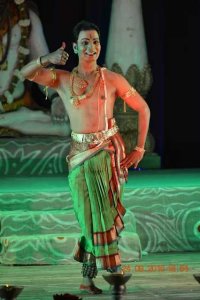 G
Ravi
Young male dancer G. Ravi from Chandranagar, performed Kuchipudi Tarangam, dancing on brass plate to Marakatamanimaya chela. It was impressive. And he seemed to have good stamina and breath control. He needs to develop abhinaya to highlight dramatic element of Kuchipudi. 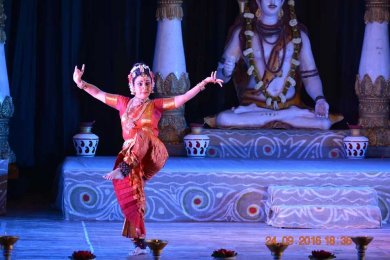 Jhinook Mukherjee Sinha 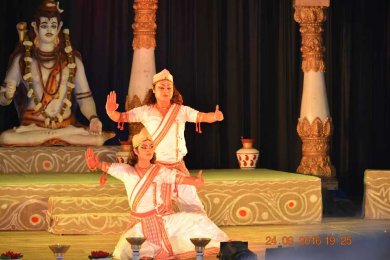 Dipjyoti and Dipankar Sattriya dancers Dipjyoti and Dipankar in their duet displayed definite Sattriya style. Currently they are studying under Ramakrishna Talukdar and have therefore developed art of stage presentation. Last I had seen them at Jiwan Pani's memorial dance festival in Delhi. From that time within a year they have acquired more skill and despite the speed not much seen in Sattriya exposition, they looked graceful and revealed the basic movements of Sattriya. Besides Prarthana, Bargeet of Sankaradev, their Dashavatara in Brajbuli was in traditional Sattriya style to the text which is based on Gita Govinda. The incarnations were enacted one after another briefly but suggestively. As happens for Narasimha and Vamana incarnations, the audiences everywhere understand the visuals and applaud. The dancers also created four armed god Vishnu's image. It gave the flavour of Sattriya music and variation in hastas different from Abhinayadarapana. One of the dancers is too slim and needs to put on weight so both would look pleasant in a duet. Sandip Malik, a disciple of Shreelekha Mukhejee, in Kathak group choreography, showed his imaginative approach as a devotee praising Lord Shiva as Hara and Hari, Lord Krishna. He dovetailed lots of traditional Kathak technique of both Jaipur and Lucknow gharana. His enthusiastic troupe has well trained male and female dancers. While describing the epithets of Lord Shiva, he laid stress on tandava and while praising Lord Krishna he laid stress on lasya. Also while enacting Krishna's deeds, he brought in tala rasaka, garba, playing with claps and 'gof ' raas, using like Maypole, coloured long garlands hanging and dancers holding them dancing in circle. The Jaipur technique was sound as was graceful Lucknow training. Taking inspiration from Birju Maharaj, he also used mere clapping and sound of ankle bells which looked refreshing. But his over enthusiasm took better of him. However, the overall choreographic approach was pleasant. That he is able to manage two groups in a seamless manner was his plus point. He would do well to edit his choreography from excessive technical display. As usual the group won rounds of applause for their tatkar, footwork and chakkars. 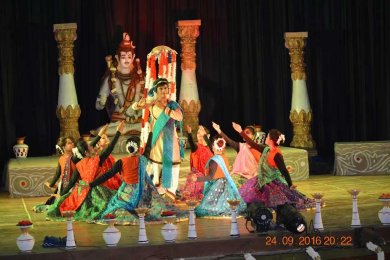 Sandip Malik's group 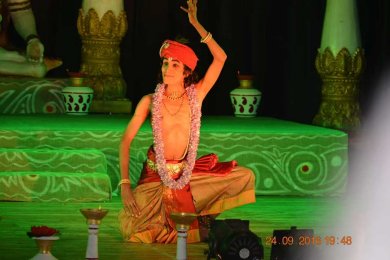 Ullal The jugalbandi between Yakshagana and Bharatanatyam was perhaps included for novelty. The idea was convincing with sequence of king Kansa in a nightmare seeing Krishna everywhere and trying to kill him and not finding him on waking up. In finale Krishna vanquishes him. In this duet also dancer playing Krishna was too thin whereas on account of costumes in Yakshagana the artist playing demon king Kansa looked larger than life. Visually Krishna cut a sorry figure. Both the artists need to work out a strategy to avoid this discrepancy. Sujata Mohapatra in Odissi presented Durga stuti rendered melodiously by Debasish Sarkar. Guru Kelucharan Mohapatra's choreography invoking Goddess Durga both in her beatific and demonic forms creates visuals of the Goddess with epithets like face like full moon and two eyes decorate it with divinity. Durga is sulochana, with beautiful eyes, pinnota payodhara, with full rounded breasts, holds in arms sudarshan chakra and other weapons, she is Mahashakti and with pointed arrows kills Mahishasura.The illusion of ten arms springing holding weapons is complete with Sujata creating an aura around her. In one word Goddess incarnate. She is a gifted dancer who succeeds in breathing life into character she depicts. She chose to present Ramayana episodes of golden deer, in her typical signature jumps, Ravana kidnapping Sita, Jatayu fighting with Ravana, Rama's blessing him when he dies and leaving in search of Sita-everything was enacted with intense abhinaya, touching chords of our heart. It is true as Sanskrit saying says the appeal of Ramayana will continue for mankind as long as there are oceans and mountains. Sujata's Odissi was the highlight of the evening, with dramatic lighting by Jaydev. 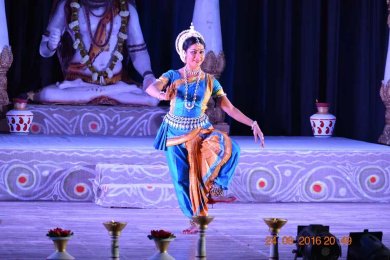 Sujata Mohapatra 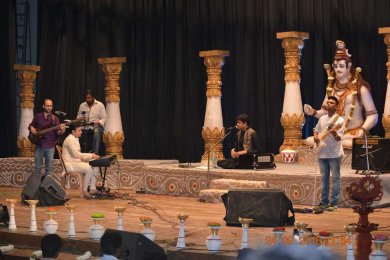 Music group The finale with musicians Sourendra, Soumyen and accompanists kept audience in thrall. Their rendering songs to Khamaj raga preferred by Sachin Deb Barman with film songs enthused audience to hum those familiar songs with them. Both musicians believe in educating audiences through these songs about classical ragas. Yaman, Bhairavi and Tillana by Balamuralikrishna were so thrilling that Tillana is known in their repertoire as Thrillana! And it was thrilling! Dhrupad, raga Shri to Tagore's song had great appeal to predominantly Bengali audience. Since the programme extended too long, despite public demand they concluded their performance, keeping audience hungry for next show. On second day I attended in the morning dance competition for young dancers. Since we had arrived by car from Kolkata previous day by 4pm we had not seen the competition of Kathak, Odissi and Kuchipudi. We only saw young dancers competing in Bharatanatyam. From Sanitiniketan, Kathakali guru and retired Professor T.Sankaranarayanan and Manipuri Guru Jitendra Singh were invited and also Sujata Ramalingam for Bharatanatyam. She is a former dancer from Chandralekha's troupe. The standard was encouraging. Dancers came from Asansol, Bardhaman, Kolkata and few from Durgapur. Organizers give three prizes for first, second and third positions and also invite them to perform next year. This is a welcome activity in a city like Durgapur. . The evening opened with group dance in Mohiniattam, with Swarnadeepa and her disciples. Swarnadeepa has a striking stage presence. Her movements are graceful and she follows Kerala Kalamandalam style. Prayer to Ganapati was cast in group choreography with the lord with four arms and in front, his vehicle mushak, mouse. Other dancers on either side created a group of devotees. All dressed in traditional Kerala sarees with bun on one side and talasaman, the hair ornaments creating impressive visuals. Till I saw this work, it was difficult for me to believe that somewhere in Durgapur, Mohiniattam is so perfectly practiced. The ashtapadi Lalitalavangalata parishilan from Gita Govinda in group dance gave ample scope for rasalila, Krishna playing with other Gopis. And description of spring, its effect on animals, birds and human beings. The uniform training was apparent and the pains taken by Swarnadeepa were obvious. The two Manipuri numbers by Surojit Deb Barman and Yoganand Singh created serene mood of bhakti with their Dashavatara number. Complementing each other they performed the various avataras clearly, one standing in final pose with hasta mudra of the avatara and other as devotee bowing to him. The khandita nayika Yahi keshava and Krishna's Priye Charushile was movingly performed, with Radha unable to bear Krishna's begging her to place her lotus feet on his head: Dehi padapalavamudaram. A touching sequence. Restrained abhinaya and angikabhinaya, "the eloquent silence" of Manipuri was appealing. Both artists have very good training in traditional Manipuri. It was a pleasure to see these unknown artists during this festival. 25th September was International daughter's day. And appropriately mothers and daughters performed. The one set was of Sonalika and Sreenika, the 6 year child prodigy dancing in Odissi and the other were Prateeksha Kashi and her mother Vyjayanthi Kashi performing duets in Kuchipudi. Sonalika from Bangalore danced in Megh raga, Ratikant Mohapatra's choreographed Pallavi gracefully. I first time saw Shreenika two years ago at Naman dance festival of Madhulika Mohapatra in Bangalore. Like all, I was charmed by her ability to dance in rhythm, tala and laya despite her young age but with natural gifts. Seeing her mother Sonalika and she dance together looked extremely tantalising. Shreenika and Sonalika performed Madhurashtakam. They wove in childhood pranks of Krishna. Breaking pots, stealing butter with other cowherd boys, showing Universe in mouth when Yashoda chides Krishna for eating earth et al were performed in a seamless manner, and the two dancing in joy made it beautiful. In the end Shreenika stood on upper platform and Sonalika bowed to her with folded hands. The audience gave them a standing ovation. Mr. Apoorva Mukherjee, the Mayor of Durgapur, who was the chief guest, recalled the days when years ago Swarnadeepa's mother had approached him to assist her to start classes for Swarnadeepa to train local dancers. As a compere Swarandeepa's mother kept the audience entertained. Both mother and daughter have, he said, succeeded in creating a love for dance in Durgapur and within two years have created an audience. Since it was an international daughter's day he praised Swarnadeepa's mother and Swarnadeepa for arranging performances of mothers and daughters. Vyjayanthi Kashi and her daughter Prateeksha Kashi are seasoned dancers and succeed in entertaining audiences with their duet performances with admirable dramatic elements. The Vande Bhavani prayer followed with episode of Trivakra, Kubja in which Parteeksha as Krishna and Vyjayanthi Kashi as Kubja performed with characteristic natyadharmi mode, the dramatic element, the agony of Kubja with her physical deformity and her wish to have a look at Krishna while working in court of the demon king Kansa, Krishna appearing before Kubja and encouraging her to apply sandal paste on his body and Kubja transforming into a beautiful woman, were enacted with consummate artistry. Young sprightly Prateeksha with her graceful dancing, abhinaya, with exquisite utplavanas, jumps, as youthful Krishna won over audience's admiration, whereas Vyjayanthi Kashi as Kubja with her moving abhinaya won critical appreciation from Kathakali guru T. Sankaranarayanan. So riveting was the performance that the audience stood up spontaneously giving them standing ovation. Perhaps this was for the first time that the Durgapur audience had seen such a thrilling performance. Then followed the young dancers from Saurabh group from Kolkata, with eight dancers in Bharatanatyam. Since Durgapuja is in the air, they performed numbers in prise of Goddess and created images of Dashabhuja, ten armed Goddess in a very impressive manner. What was interesting was anointing the goddess performing Durga with sindoor, vermillion and placing scarves on her and flowers at her feet, keeping her on upper platform and all on either side bowing to the goddess. Its appeal to the audience is eternal. And the lead dancer received praise from one and all. It was late for me so I missed the popular TV musicians who rendered vocal songs. Earlier from Santinketan, Sutanu had played on Esraj, which was a popular instrument during Tagore's time and in Santiniketan training is still given to young musicians. The senior critics are invited to major festivals in metro cities. The organizers from Durgapur decided to bring to my notice what they are doing in a remote city like Durgapur. I am glad I attended the festival. It was an eye opener for me. My suggestions to organizers are as follows. Not having sponsors will deplete their financial resources. They will have to approach senior most officers at Steel Plant with help of the Mayor and other well wishers, also enlist support from CM and Rajya Sangeet Natak Akademi from Kolkata, seek sponsorship of hotels, and try to overcome the unpleasant effect of globalization where corporate support only goes for Bollywood and Reality shows. It is an uphill task, but having registered their institution for eight years, they need to approach SNA, EZCC and other agencies for finances. A concentrated effort from now on would result in some success, because there is no other institution in Durgapur, serving the cause of classical dances. The support from Kolkata based Kathakali actor Kalamandalam Gautam was excellent in guiding them. I am confident that in coming years, Durgapur Festival of dance and music will go from strength to strength.  Dr. Sunil Kothari is a dance historian, scholar, author and critic. He is honored with Padma Shri, Sangeet Natak Akademi award and Senior Critic Award from Dance Critics Association, NYC. Post your comments Please provide your name and email id when you use the Anonymous profile in the blog to post a comment. All appropriate comments posted with name & email id in the blog will also be featured in the site. |